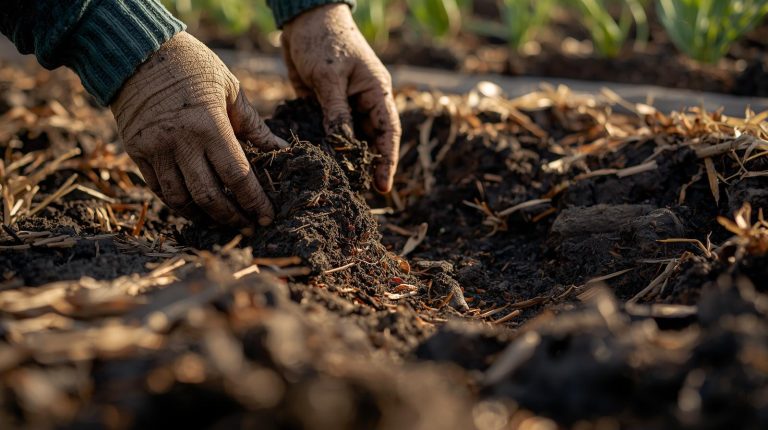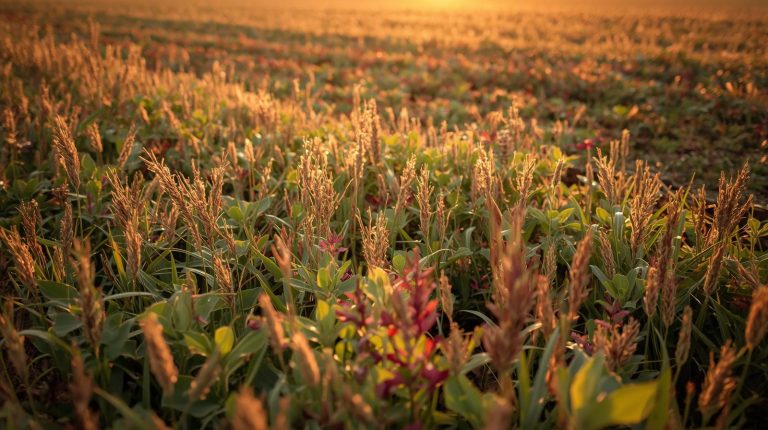Are you ready to embark on a rewarding journey of home organic farming? Look no further! We’ve got you covered with our step-by-step guide, designed to help you create a flourishing and sustainable garden right in your own backyard.
From choosing the ideal location to harvesting your bountiful produce, we’ll walk you through every aspect of this fulfilling endeavor. Get ready to join a community of like-minded individuals and discover the joy of growing your own organic food.
Let’s get started!
Choosing the Right Location
We carefully select a suitable location for our home organic farm. Choosing the right location is crucial for the success of our farm. We need to optimize sunlight exposure to ensure healthy plant growth and maximum crop yield.
When selecting a location, we consider factors such as the amount of sunlight that the area receives throughout the day, the presence of any shade from nearby trees or buildings, and the direction in which the sun rises and sets. It’s important to find a spot that receives at least six hours of direct sunlight each day.
Preparing the Soil
To optimize the conditions for healthy plant growth and maximum crop yield, it’s essential to focus on preparing the soil for our home organic farm.
Before planting, it’s important to conduct a soil test to determine its pH level and nutrient content. This will help us understand the soil’s composition and identify any deficiencies or imbalances.
Based on the test results, we can then amend the soil by adding organic matter such as compost, manure, or cover crops. These amendments will improve the soil structure, increase its ability to hold water and nutrients, and promote beneficial microbial activity.
Additionally, adding organic matter will enhance the soil’s fertility and encourage the growth of healthy plants.
Selecting Organic Seeds or Seedlings
When it comes to starting an organic garden, one of the first decisions to make is whether to use seeds or seedlings.
Seeds offer a wider variety of options and can be more cost-effective, but they require more time and care to grow.
On the other hand, seedlings are already started plants that can be transplanted directly into the garden, saving time and effort.
Knowing where to buy organic seeds or seedlings is also crucial, as reputable suppliers ensure the quality and authenticity of the plants.
Seed Vs. Seedling
For successful home organic farming, it’s crucial to carefully select the appropriate quantity of organic seeds or seedlings needed for your garden. When deciding between seeds and seedlings, there are several factors to consider.
Buying options for organic seeds are vast, ranging from local nurseries to online retailers. Seeds offer the advantage of variety, allowing you to choose from a wide selection of plant types. They’re also more cost-effective, as you can save and store leftover seeds for future use. However, seeds require more time and effort to grow into mature plants.
On the other hand, buying organic seedlings from local nurseries or farmers markets can save you time and effort. Seedlings have a head start in growth, so you’ll see results sooner. However, they may have limited variety and higher costs compared to seeds.
Ultimately, the choice between seeds and seedlings depends on your preferences, resources, and goals for your home organic farm.
Where to Buy?
We can find a variety of options for purchasing organic seeds or seedlings to start our home organic farming journey. When it comes to finding organic seeds or seedlings, it’s important to consider trusted sources that prioritize organic practices.
One option is to visit local organic farmers’ markets or nurseries, where you can find a wide selection of organic seeds and seedlings.
Another option is to look for online retailers that specialize in organic gardening supplies. These retailers often provide detailed information about the seeds or seedlings they offer, allowing you to make informed choices.
Additionally, joining local organic farming communities or groups can provide opportunities for seed or seedling swaps, where you can exchange varieties with fellow organic farmers.
Implementing Natural Pest Control Methods
When it comes to implementing natural pest control methods in home organic farming, there are a few effective strategies to consider.
One option is to attract beneficial insects that act as predators, such as ladybugs and lacewings, to help control pests naturally.
Another method is companion planting, where certain plants are grown together to provide protection against pests.
Beneficial Insects as Predators
To effectively implement natural pest control methods in home organic farming, it’s essential to incorporate beneficial insects as predators. Beneficial insects play a crucial role in managing pest populations and maintaining a healthy balance in the ecosystem. They’re nature’s own pest control agents and can help reduce the need for harmful chemical pesticides.
Ladybugs, lacewings, and praying mantises are examples of beneficial insects that feed on pests like aphids, mites, and caterpillars. By attracting and encouraging these beneficial insects to your garden, you can maintain a natural and sustainable approach to pest management.
Providing habitat, such as native plants and bug hotels, and avoiding the use of synthetic pesticides are organic pest control alternatives that support beneficial insect populations.
Companion Planting for Protection
Implementing natural pest control methods in home organic farming includes incorporating companion planting for protection. Companion planting involves growing certain plants together to enhance the growth and health of the entire garden while deterring pests naturally.
Here are five beneficial plants and intercropping techniques to consider:
- Marigolds: Plant marigolds near vegetables to repel aphids, nematodes, and other harmful insects.
- Basil: Plant basil near tomatoes to repel tomato hornworms and other pests.
- Nasturtiums: These flowers attract aphids, which helps protect other plants by diverting the pests away.
- Garlic: Plant garlic near roses to repel aphids, Japanese beetles, and other pests.
- Beans: Intercropping beans with corn and squash creates a natural barrier that deters pests and improves soil fertility.
Watering and Irrigation Techniques
Using a drip irrigation system is an efficient and eco-friendly way to provide consistent moisture to your home organic garden. Drip irrigation delivers water directly to the roots of your plants, minimizing water waste and reducing the risk of overwatering. This technique ensures that your plants receive the right amount of water they need, promoting healthy growth and minimizing the occurrence of diseases caused by excessive moisture.
Additionally, drip irrigation can be combined with rainwater harvesting, allowing you to collect and utilize rainwater to irrigate your garden. Rainwater harvesting involves collecting rainwater from rooftops or other surfaces and storing it in containers or barrels. This sustainable practice not only conserves water but also reduces your reliance on municipal water supplies.
Maintaining Organic Fertilization Practices
Now, let’s delve into how we can effectively maintain organic fertilization practices in our home organic garden. Here are five important tips to help you achieve this:
- Composting Techniques: Start composting kitchen scraps, yard waste, and other organic materials to create nutrient-rich compost that can be used as natural fertilizer for your plants.
- Soil Testing: Regularly test the soil in your garden to determine its nutrient levels. This will help you understand what specific nutrients your plants need and allow you to adjust your fertilization practices accordingly.
- Crop Rotation: Rotate your crops each season to prevent nutrient depletion in the soil. Different plants have varying nutrient needs, so rotating them helps maintain a balanced soil fertility.
- Cover Crops: Plant cover crops like legumes or grasses during the off-season to improve soil health and fertility. These crops help fix nitrogen and prevent erosion.
- Organic Amendments: Use organic amendments like compost, manure, or bone meal to enrich the soil and provide essential nutrients for your plants.
Harvesting and Storing Organic Produce
To ensure the successful harvest and long-term storage of our organic produce, we rely on proper techniques and attentive care.
Harvesting techniques are crucial to preserve the quality and flavor of our crops. We carefully choose the right time to pick our fruits and vegetables, ensuring they’re ripe and at their peak of freshness. Gentle handling during harvest minimizes damage and bruising.
Once harvested, we employ the best storage methods to extend the shelf life of our organic produce. Cool, dark, and well-ventilated spaces, such as root cellars or refrigerators, are ideal for storing most fruits and vegetables. Some crops, like potatoes and onions, prefer dry and cool conditions.
Troubleshooting Common Organic Farming Issues
Our team’s experience in home organic farming has taught us to anticipate and address common issues that can arise in the process. When it comes to organic farming, dealing with pest problems and weed control are two of the most common challenges.
Here are some techniques we’ve found effective:
- Companion planting: Planting certain crops together can help deter pests and promote healthy growth.
- Natural predators: Encouraging beneficial insects and animals, such as ladybugs and birds, can help control pest populations.
- Organic pesticides: Using targeted, organic pesticides can help combat specific pest problems without harming the environment.
- Mulching: Applying mulch around plants can suppress weeds and conserve moisture, reducing the need for manual weeding.
- Crop rotation: Rotating crops each season can help break pest and disease cycles, reducing the risk of infestations.
Conclusion
In conclusion, by following this step-by-step guide to home organic farming, you can cultivate a thriving garden filled with nutritious and delicious produce. From choosing the right location to implementing natural pest control methods, each step is essential for success.
With proper watering techniques and organic fertilization practices, your garden will flourish. So start today and enjoy the bountiful harvests, all while knowing that you’re contributing to a healthier and more sustainable future.
Happy farming!




